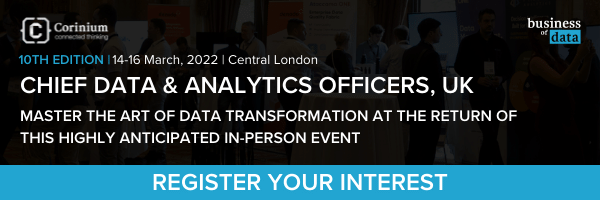Top 100 Data Innovator 2022: NatWest’s Zachery Anderson

Zachery Anderson, Chief Data and Analytics Officer at NatWest, shares his key achievements to date and strategic goals for 2022
Would you please start by telling us a bit about your greatest achievements at NatWest over the past 12-24 months?
I would say that the way the team has come together across the bank during the pandemic while also driving transformation around data and analytics has been pretty incredible. They’ve been juggling homeschooling and working from home and at the same time really aggressively changing the agenda within the bank. That’s amazing.
In the early days of the pandemic, we were quickly able to identify NHS employees that were customers and build a system to proactively contact them and deliver tailored support. When they were working around the clock taking care of people, we made sure they were able to utilize our banking services and get the support they needed.
On the more technical side, we’ve developed an incredible set of graph capabilities around identity that has enabled us to build a propriety first-party fraud system. We can bring together data such as mobile identity, home address, phone number, all associated parties and names for an account and then view all of the transactions between them on a full graph of all activity.
We can identify someone who has received fraudulent funds and see all the people they are connected to. In the first couple of weeks, we found fraud rings that were much larger than anybody had ever found before because we’re able to look at all the accounts and exit them at once. It’s phenomenal.
Graph technology has also expanded our understanding of risk. When a company that sits on the top of the food chain goes bankrupt, it has a really big impact across sectors. What we’ve been able to do is build multi-level graphs and connectivities at a massive scale, including analyzing algorithmically what percentage of revenue is tied to other companies.
The results were surprising. Usually, you would see a halving of impact as you go out on the graph. But actually, it often operated the opposite way because our graph is catching the smaller companies and seeing the impact increase as we move out towards the second and third tiers.
First-tier suppliers were big enough that they could handle losing one of their customers but the second and third-tier suppliers were vulnerable. They’re not the ones that people usually gave much attention. These were cross-sector, such as food suppliers who might exclusively make bread for an airline that’s out of business. That’s where you discover these dependencies across chains creating risk problems that hadn’t been identified before.
How has data and analytics maturity at NatWest evolved over the past 12 months?
COVID has been a real catalyst for the maturation of data and analytics. At the highest level, it’s thrown all the chips up in the air. People didn’t know what was going to happen, they didn’t know what the impacts were going to be. They weren’t sure of the risk to our portfolio, the economy, and/or behavioral change in our customers. Because of that, nobody had a gut instinct, they had to rely on the data to be able to make decisions. That forced a lot of executives and senior people to suddenly look at the data.
That has driven a lot from the demand side. On the supply side, we’ve had to raise our game to meet that demand. We’ve had to do a lot of work around tooling and data quality to make sure that what we were supplying to the executives made sense. We developed what we called a “gold dashboard” which was all the key metrics of the bank, reported daily up to the executives.
There’s been an overall maturation of the group, our systems, and our data quality standards. It’s a 300-year-old bank, so in some cases, we’re using quantum computing and in others, we have things running through a mainframe. We have one of the most used banking apps in the world and at the same time, we’re managing parts of our business by manual processes. We’ve built a plan to systematically start to decommission and unwind those going forward.
What will your key priorities be in 2022?
My expectation is by the end of 2022 we’ll have massively built up our workforce of data scientists and data engineers. We have added over 200 new staff to those groups, and we’ll do even more than that next year. We’ll have shifted the data group to be internal rather than primarily consultant-based, so that will be the biggest shift.
Second is the continued development of our internal identity system called Customer DNA, which is built on a real-time, ODS-driven system. By the end of 2022, all customer data should have moved to it and connected to the vast majority of customer interactions through sensor-like capabilities. It’s going to be a big year!
Zachery Anderson is one of our 2022 Global Top 100 Innovators in Data and Analytics. To discover the full list and exclusive interviews with this year's 'top 100', click here now.
Zachery Anderson will be headling CDAO UK in London on 14-16 March as a Keynote Speaker. To join his presentation 'From One-Time Buyer to Long-Term Customer – Utilising Data to Convert One-Off Purchasers into Loyal Customers', click here to register your interest.


.png?width=352&name=Global%20Innovators%20in%20Data%20%26%20Analytics%20Top%20100%20Report%2c%202022%20(1).png)

.png?width=352&name=Featured%20Images%20(19).png)